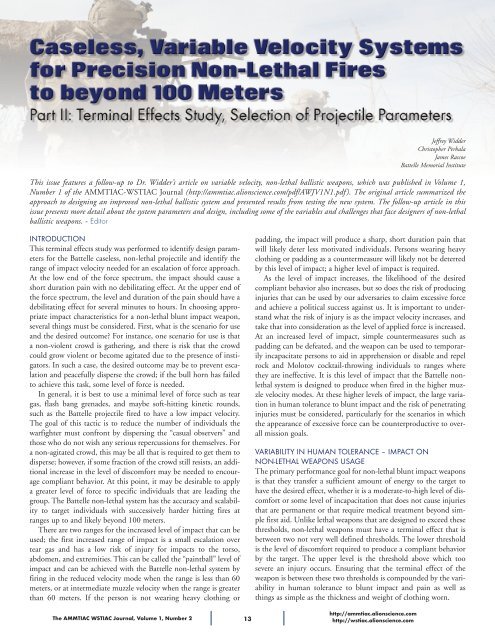AMMTIAC-WSTIAC Journal, Vol. 1, No. 2 - Advanced Materials ...
AMMTIAC-WSTIAC Journal, Vol. 1, No. 2 - Advanced Materials ...
AMMTIAC-WSTIAC Journal, Vol. 1, No. 2 - Advanced Materials ...
- No tags were found...
Create successful ePaper yourself
Turn your PDF publications into a flip-book with our unique Google optimized e-Paper software.
Jeffrey WidderChristopher PerhalaJames RascoeBattelle Memorial InstituteThis issue features a follow-up to Dr. Widder’s article on variable velocity, non-lethal ballistic weapons, which was published in <strong>Vol</strong>ume 1,Number 1 of the <strong>AMMTIAC</strong>-<strong>WSTIAC</strong> <strong>Journal</strong> (http://ammtiac.alionscience.com/pdf/AWJV1N1.pdf). The original article summarized theapproach to designing an improved non-lethal ballistic system and presented results from testing the new system. The follow-up article in thisissue presents more detail about the system parameters and design, including some of the variables and challenges that face designers of non-lethalballistic weapons. - EditorINTRODUCTIONThis terminal effects study was performed to identify design parametersfor the Battelle caseless, non-lethal projectile and identify therange of impact velocity needed for an escalation of force approach.At the low end of the force spectrum, the impact should cause ashort duration pain with no debilitating effect. At the upper end ofthe force spectrum, the level and duration of the pain should have adebilitating effect for several minutes to hours. In choosing appropriateimpact characteristics for a non-lethal blunt impact weapon,several things must be considered. First, what is the scenario for useand the desired outcome? For instance, one scenario for use is thata non-violent crowd is gathering, and there is risk that the crowdcould grow violent or become agitated due to the presence of instigators.In such a case, the desired outcome may be to prevent escalationand peacefully disperse the crowd; if the bull horn has failedto achieve this task, some level of force is needed.In general, it is best to use a minimal level of force such as teargas, flash bang grenades, and maybe soft-hitting kinetic rounds,such as the Battelle projectile fired to have a low impact velocity.The goal of this tactic is to reduce the number of individuals thewarfighter must confront by dispersing the “casual observers” andthose who do not wish any serious repercussions for themselves. Fora non-agitated crowd, this may be all that is required to get them todisperse; however, if some fraction of the crowd still resists, an additionalincrease in the level of discomfort may be needed to encouragecompliant behavior. At this point, it may be desirable to applya greater level of force to specific individuals that are leading thegroup. The Battelle non-lethal system has the accuracy and scalabilityto target individuals with successively harder hitting fires atranges up to and likely beyond 100 meters.There are two ranges for the increased level of impact that can beused; the first increased range of impact is a small escalation overtear gas and has a low risk of injury for impacts to the torso,abdomen, and extremities. This can be called the “paintball” level ofimpact and can be achieved with the Battelle non-lethal system byfiring in the reduced velocity mode when the range is less than 60meters, or at intermediate muzzle velocity when the range is greaterthan 60 meters. If the person is not wearing heavy clothing orThe <strong>AMMTIAC</strong> <strong>WSTIAC</strong> <strong>Journal</strong>, <strong>Vol</strong>ume 1, Number 2 13padding, the impact will produce a sharp, short duration pain thatwill likely deter less motivated individuals. Persons wearing heavyclothing or padding as a countermeasure will likely not be deterredby this level of impact; a higher level of impact is required.As the level of impact increases, the likelihood of the desiredcompliant behavior also increases, but so does the risk of producinginjuries that can be used by our adversaries to claim excessive forceand achieve a political success against us. It is important to understandwhat the risk of injury is as the impact velocity increases, andtake that into consideration as the level of applied force is increased.At an increased level of impact, simple countermeasures such aspadding can be defeated, and the weapon can be used to temporarilyincapacitate persons to aid in apprehension or disable and repelrock and Molotov cocktail-throwing individuals to ranges wherethey are ineffective. It is this level of impact that the Battelle nonlethalsystem is designed to produce when fired in the higher muzzlevelocity modes. At these higher levels of impact, the large variationin human tolerance to blunt impact and the risk of penetratinginjuries must be considered, particularly for the scenarios in whichthe appearance of excessive force can be counterproductive to overallmission goals.VARIABILITY IN HUMAN TOLERANCE – IMPACT ONNON-LETHAL WEAPONS USAGEThe primary performance goal for non-lethal blunt impact weaponsis that they transfer a sufficient amount of energy to the target tohave the desired effect, whether it is a moderate-to-high level of discomfortor some level of incapacitation that does not cause injuriesthat are permanent or that require medical treatment beyond simplefirst aid. Unlike lethal weapons that are designed to exceed thesethresholds, non-lethal weapons must have a terminal effect that isbetween two not very well defined thresholds. The lower thresholdis the level of discomfort required to produce a compliant behaviorby the target. The upper level is the threshold above which toosevere an injury occurs. Ensuring that the terminal effect of theweapon is between these two thresholds is compounded by the variabilityin human tolerance to blunt impact and pain as well asthings as simple as the thickness and weight of clothing worn.http://ammtiac.alionscience.comhttp://wstiac.alionscience.com
















